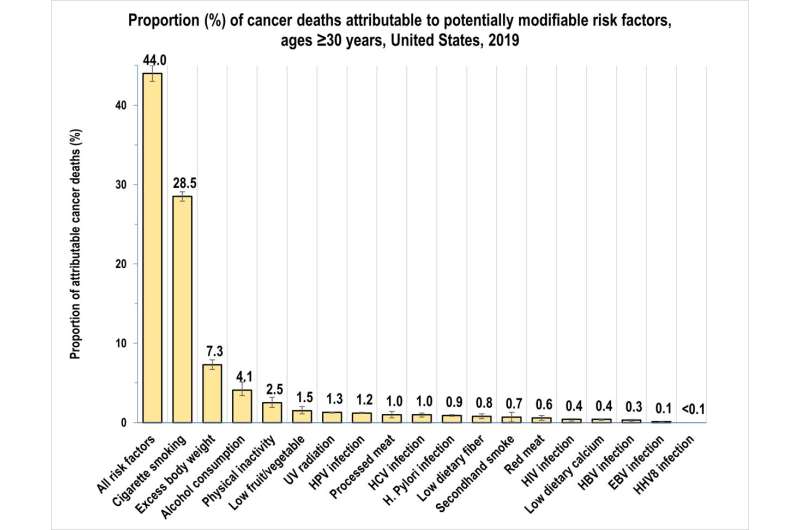This article has been reviewed according to Science X's editorial process and policies. Editors have highlighted the following attributes while ensuring the content's credibility:
fact-checked
trusted source
proofread
New study finds 40% of cancer cases and almost half of all deaths in the US linked to modifiable risk factors

A study led by researchers at the American Cancer Society (ACS) finds four in 10 cancer cases and about one-half of all cancer deaths in adults 30 years old and older in the United States (or 713,340 cancer cases and 262,120 cancer deaths in 2019) could be attributed to modifiable risk factors, including cigarette smoking, excess body weight, alcohol consumption, physical inactivity, diet, and infections.
Cigarette smoking was by far the leading risk factor, contributing to nearly 20% of all cancer cases and 30% of all cancer deaths. The findings are published in the journal CA: A Cancer Journal for Clinicians.
"Despite considerable declines in smoking prevalence during the past few decades, the number of lung cancer deaths attributable to cigarette smoking in the United States is alarming," said Dr. Farhad Islami, senior scientific director, cancer disparity research at the American Cancer Society and lead author of the report.
"This finding underscores the importance of implementing comprehensive tobacco control policies in each state to promote smoking cessation, as well as heightened efforts to increase screening for early detection of lung cancer, when treatment could be more effective
"Interventions to help maintain healthy body weight and diet can also substantially reduce the number of cancer cases and deaths in the country, especially given the increasing incidence of several cancer types associated with excess body weight, particularly in younger individuals."
In this study, researchers used nationally-representative data on cancer incidence and mortality and risk factor prevalence to estimate the proportion and number of cancer cases and deaths attributable to potentially modifiable risk factors overall (excluding non-melanoma skin cancers) and for 30 cancer types.
These risk factors included cigarette smoking (current and former smoking); secondhand smoke; excess body weight; alcohol consumption; consumption of red and processed meat; low consumption of fruits and vegetables, dietary fiber, and dietary calcium; physical inactivity; ultraviolet (UV) radiation; and infection with Epstein-Barr virus (EBV), Helicobacter pylori, hepatitis B virus (HBV), hepatitis C virus (HCV), human herpes virus-8 (HHV-8; also called Kaposi sarcoma herpesvirus), human immunodeficiency virus (HIV), and human papillomavirus (HPV).
The results showed cigarette smoking had the largest population attributable fraction (PAF) or proportion of cancer cases attributable to risk factors in the population (344,070 cases; 19.3% of all cases), contributing to 56.0% of all potentially preventable cancers in men (206,550 of 368,600) and 39.9% in women (137,520 of 344,740).
Excess body weight had the second largest PAF (7.6%), followed by alcohol consumption (5.4%), UV radiation exposure (4.6%), and physical inactivity (3.1%).
By cancer type, the proportion of cases caused by potentially modifiable risk factors ranged from 100% for cervical cancer and Kaposi sarcoma to 4.9% for ovarian cancer and exceeded 50% for 19 of 30 evaluated cancer types.
In addition to cervical cancer and Kaposi sarcoma, more than 80% of all melanomas of the skin (92.2%) and cancers of the anus (94.2%), larynx (89.9%), lung and bronchus (lung; 88.2%), pharynx (87.4%), trachea (85.6%), esophagus (85.4%), and oral cavity (83.7%) were attributable to evaluated risk factors.
Lung cancer had the largest number of cases attributable to evaluated risk factors in both men (104,410 cases) and women (97,250), followed by skin melanoma (50,570), colorectal cancer (44,310), and urinary bladder cancer (32,000) in men and by breast (83,840), corpus uteri (35,790), and colorectal (34,130) cancer in women.
"These findings show there is a continued need to increase equitable access to preventive health care and awareness about preventive measures. Effective vaccines are available for hepatitis B virus, that causes liver cancer and HPV, which can cause several cancer types, including cervical, other anogenital, and oropharyngeal cancers," added Dr. Ahmedin Jemal, senior vice president, surveillance and health equity science at the American Cancer Society and senior author of the study.
"Vaccination at the recommended time can substantially reduce the risk of chronic infection, and consequently, cancers associated with these viruses. HPV vaccination uptake in the United State is suboptimal."
Other ACS authors participating in this study include Dr. Emily Marlow, Dr. Marjorie McCullough, and Dr. Alpa Patel.
More information: CA: A Cancer Journal for Clinicians (2024)


















